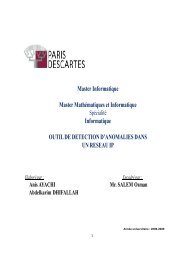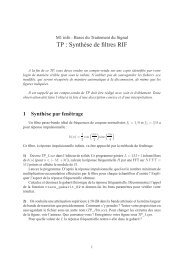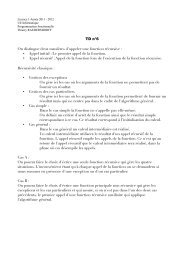Th`ese de Doctorat de l'université Paris VI Pierre et Marie Curie Mlle ...
Th`ese de Doctorat de l'université Paris VI Pierre et Marie Curie Mlle ...
Th`ese de Doctorat de l'université Paris VI Pierre et Marie Curie Mlle ...
You also want an ePaper? Increase the reach of your titles
YUMPU automatically turns print PDFs into web optimized ePapers that Google loves.
4.1 Problem Statement<br />
L<strong>et</strong> us mo<strong>de</strong>l the n<strong>et</strong>work as a directed graph G =(N,L) where no<strong>de</strong>s represent routers<br />
and directed arcs represent links. Each link l ∈ L has associated the capacity Cl. As<strong>et</strong>of<br />
K connections is offered to the n<strong>et</strong>work. Each connection is represented by the notation<br />
(sk,dk,srk,r mink), for k =1,...,K,wheresk, dk, srk and r mink represent respectively<br />
the connections source no<strong>de</strong>, <strong>de</strong>stination no<strong>de</strong>, subscribed rate and the minimum band-<br />
width the application requires to work correctly. L<strong>et</strong> a l k be the routing matrix: al k =1<br />
if connection k is routed on link l, a l k<br />
= 0 otherwise. We assume that a communication<br />
b<strong>et</strong>ween a user pair is established by creating a session involving a path that remains fixed<br />
throughout the user pair conversation duration. The session path choice m<strong>et</strong>hod (i.e., the<br />
routing algorithm) is not consi<strong>de</strong>red in this thesis. We <strong>de</strong>note the interval b<strong>et</strong>ween two<br />
successive allocations performed by the algorithm as the update interval, whose duration<br />
is Tu seconds.<br />
The goal is to <strong>de</strong>termine rn k , the amount of bandwidth allocated to each source k in the<br />
n − th update interval.<br />
At the beginning of the n − th update interval, each ingress router computes the trans-<br />
mission rate, b n−1<br />
k<br />
, and the offered load, Ol n−1<br />
k , averaged over the last Tu seconds, for all<br />
connections k ∈ K that enter the n<strong>et</strong>work through it.<br />
This information is then sent to all other ingress routers using control messages as<br />
<strong>de</strong>scribed in the previous Section, so that all ingress routers share the same information<br />
about current traffic statistics and perform simultaneously the same allocation procedure.<br />
Moreover, based on this information, connections are classified according to their traffic<br />
statistics. Such classification is taken into account in the bandwidth allocation process to<br />
distribute n<strong>et</strong>work resources and to achieve high n<strong>et</strong>work revenue.<br />
38










